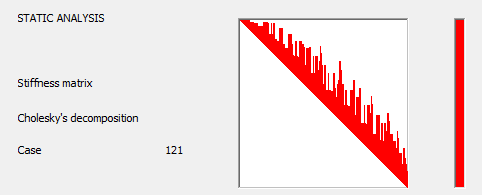The skyline method solves the K * x = b linear equation system, or the eigenvalue problems Kφ - λB φ = 0 equation system.
The skyline method is based on the Cuthill-McKee reordering method 12, a matrix profile scheme, and the Crout factorization technique ![]() 3.
3.
This method is applied when solving either a linearized equation set or an eigenvalue problem Kφ - λBφ = 0 (modal and buckling analysis). If the second matrix B is consistent (modal analysis with consistent mass matrix or buckling), then it is stored by means of the profile method (as is the K matrix). All required consistent matrices for different types of analyses are also stored by means of the profile method. For example, a stress-stiffened matrix for nonlinear and buckling analysis and a dynamic matrix K - λB for Sturm sequence check and harmonic analysis.
Specifications
- Memory use: low
- Disk use: high
- Speed estimation: slow
- Quantity of equations: up to 50000 equations.
- Supported analyses: All.
- Available analysis limitations: N/A
- Additional remarks:The Skyline method often allows you to obtain numbers of nodes and degrees of freedom for equations leading to calculation problems such as incorrectly restricted structures.
Skyline Method calculations
-
- Model reduction (renumbering of nodes and elements)
- Definition of the stiffness matrix for individual structure elements
- Matrix decomposition (Cholesky decomposition)
- Number of blocks.
- Division of the stiffness matrix. A part of the matrix is saved on the disk, slowing calculations.
- Problem solving for successive load cases.
